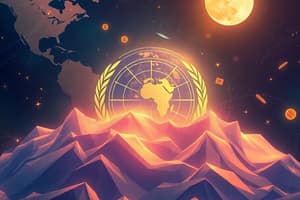Podcast
Questions and Answers
What is the primary goal of trade liberalization?
What is the primary goal of trade liberalization?
- To increase tariffs on imports
- To limit access to foreign markets
- To reduce barriers to international trade (correct)
- To create more trade barriers
Which statement accurately describes the General Agreement on Tariffs and Trade (GATT)?
Which statement accurately describes the General Agreement on Tariffs and Trade (GATT)?
- It was established to increase trade barriers.
- Its goal is to treat goods from one’s own country preferentially.
- It ensures that domestic industries are not protected.
- It promotes equality among all trading nations. (correct)
What was a significant outcome of the North American Free Trade Agreement (NAFTA)?
What was a significant outcome of the North American Free Trade Agreement (NAFTA)?
- It added Mexico to the trading bloc of the US and Canada. (correct)
- It was exclusively beneficial for Canadian producers.
- It decreased trade across North America.
- It removed trade relations between the US and Canada.
What does free trade primarily entail?
What does free trade primarily entail?
The World Trade Organization (WTO) aims to improve international trade relations by encouraging what action?
The World Trade Organization (WTO) aims to improve international trade relations by encouraging what action?
Which of the following best describes a trading bloc?
Which of the following best describes a trading bloc?
The United States Mexico Canada Agreement (USMCA) changed production requirements by increasing what percentage of North American vehicle production?
The United States Mexico Canada Agreement (USMCA) changed production requirements by increasing what percentage of North American vehicle production?
What was one of the main purposes of the Free Trade Agreement (FTA) between the US and Canada?
What was one of the main purposes of the Free Trade Agreement (FTA) between the US and Canada?
What key feature of the Gold Standard required a country to hold a specific asset?
What key feature of the Gold Standard required a country to hold a specific asset?
What is a consequence of printing more money when the economy is in debt?
What is a consequence of printing more money when the economy is in debt?
How did the U.S. lifting the Gold Standard affect global currency systems?
How did the U.S. lifting the Gold Standard affect global currency systems?
What is the primary function of the World Bank?
What is the primary function of the World Bank?
What is a significant characteristic of the International Monetary Fund's (IMF) operations?
What is a significant characteristic of the International Monetary Fund's (IMF) operations?
Which of the following is true about how contributions to the IMF are determined?
Which of the following is true about how contributions to the IMF are determined?
What was one of the main problems associated with the criteria set by the World Bank?
What was one of the main problems associated with the criteria set by the World Bank?
What aspect of currency valuation is primarily influenced by a country's economic power?
What aspect of currency valuation is primarily influenced by a country's economic power?
What was the primary purpose of the Bretton Woods Agreement signed in 1944?
What was the primary purpose of the Bretton Woods Agreement signed in 1944?
Which institutions were established as a result of the Bretton Woods Conference?
Which institutions were established as a result of the Bretton Woods Conference?
What was a significant outcome of the Bretton Woods Conference regarding international trade?
What was a significant outcome of the Bretton Woods Conference regarding international trade?
In what way did the International Monetary Fund (IMF) influence global finance after its formation?
In what way did the International Monetary Fund (IMF) influence global finance after its formation?
Which statement best describes the function of the World Bank?
Which statement best describes the function of the World Bank?
What economic ideology did the Bretton Woods Conference initially promote?
What economic ideology did the Bretton Woods Conference initially promote?
Which economic system was widely discussed during the Bretton Woods Conference in relation to rebuilding economies?
Which economic system was widely discussed during the Bretton Woods Conference in relation to rebuilding economies?
What primary need led to the establishment of the Bretton Woods Conference?
What primary need led to the establishment of the Bretton Woods Conference?
Flashcards
Bretton Woods Agreement
Bretton Woods Agreement
Rules set up the post-war global economy.
Gold Standard
Gold Standard
Currency value backed by a country's gold reserves.
Fixed Exchange Rate
Fixed Exchange Rate
Government-set currency values.
Inflation
Inflation
Signup and view all the flashcards
Floating Exchange
Floating Exchange
Signup and view all the flashcards
World Bank
World Bank
Signup and view all the flashcards
International Monetary Fund (IMF)
International Monetary Fund (IMF)
Signup and view all the flashcards
Currency Value
Currency Value
Signup and view all the flashcards
Bretton Woods Conference
Bretton Woods Conference
Signup and view all the flashcards
Post-War Global Economy
Post-War Global Economy
Signup and view all the flashcards
Need for Post-War Reconstruction
Need for Post-War Reconstruction
Signup and view all the flashcards
Establishing Global Economic Rules
Establishing Global Economic Rules
Signup and view all the flashcards
Expansion of Free Market
Expansion of Free Market
Signup and view all the flashcards
Trade Liberalization
Trade Liberalization
Signup and view all the flashcards
Tariff
Tariff
Signup and view all the flashcards
Free Trade
Free Trade
Signup and view all the flashcards
Trading Bloc
Trading Bloc
Signup and view all the flashcards
General Agreement on Tariffs and Trade (GATT)
General Agreement on Tariffs and Trade (GATT)
Signup and view all the flashcards
Free Trade Agreement (FTA)
Free Trade Agreement (FTA)
Signup and view all the flashcards
North American Free Trade Agreement (NAFTA)
North American Free Trade Agreement (NAFTA)
Signup and view all the flashcards
United States Mexico Canada Agreement (USMCA)
United States Mexico Canada Agreement (USMCA)
Signup and view all the flashcards
Study Notes
Unit 3: Globalization & Sustainable Prosperity
- The unit explores the extent to which globalization contributes to sustainable prosperity for everyone.
- Economic globalization is a key focus.
Economic Globalization
- Economic ideas have significantly influenced contemporary economic globalization.
- Key economic ideas include, how money works, establishing a money system through the World Bank and International Monetary Fund, and the expansion of free markets to previously communist countries.
Focus on Monetary Systems
- The establishment of a global money system is a central part of globalization.
- Focuses on how World Bank and International Monetary Fund operate.
- Focus on the expansion of free markets to communist countries in Europe.
Auto Pact
- This section likely discusses a specific agreement or pact focusing on the car sector, likely the Canada-United States Auto Pact.
Bretton Woods Conference
- The Bretton Woods Conference was a crucial meeting after World War II.
- This meeting was to rebuild war-torn economies.
- The Bretton Woods Agreement created rules and international organizations for the global economy.
- The conference involved 44 participating countries.
- Financial institutions like the World Bank and the International Monetary Fund (IMF) were established as part of the Bretton Woods Agreement, aiming to promote international trade.
Countries Attended the Bretton Woods Conference
- Key countries involved were the USA, Canada, Western Europe, Japan, and Australia.
New International Monetary System
- A need arose to rebuild Europe following World War II.
- Allies established a new standard to rebuild the global economy.
- The Bretton Woods Agreement established the rules and regulations for this new post-war economic system.
The Gold Standard
- All money printed had to be backed by a country's gold reserves.
- A fixed-exchange rate was necessary for the value of money.
- Issues of inflation and the need to borrow money or print more were discussed as potential difficulties with the gold standard.
The Problem Made Worse: Inflation
- The need to borrow or print money sometimes leads to increased debt.
- Increased debt leads to the possibility of inflation; where money loses value.
Floating Exchange
- The US shifted away from the gold standard due to debt.
- This change impacted other countries, leading to floating exchange rates.
- These rates are driven by supply and demand which influence the currency value.
Value of Money
- Money's value reflects a country's economic strength and power.
- Often countries base their own currencies on the US dollar.
The World Bank
- Established as part of the UN.
- Works independently of other UN members.
- Provides financial aid to specific countries based on political and economic criteria.
International Monetary Fund (IMF)
- Works with the World Bank, offering short-term solutions for countries.
- Monitors exchange rates globally.
- Provides loans to countries based on economic strength.
- Countries contribute to the IMF based on their economic size.
Free Market Expansion
- Economic shift after the fall of the Iron Curtain emphasized free-market economies.
- Centralized planned economies (government controlled) are opposite to free markets.
- Major countries like India and China also adopted a more free-market approach.
Economic Globalization: Free Trade (3.5)
- Globalization emphasized the removal of trade barriers, meaning tariffs.
Trade Liberalization
- Removing obstacles to international trade, particularly tariffs, was a major component of globalization.
Tariffs
- A tariff is a tax placed on imported or exported goods.
Free Trade
- Free trade resulted from trade liberalization.
- It meant that few restrictions were placed on global trade.
Trading Blocs
- Trading blocs are groups of nations interacting to offer each other better trading terms.
General Agreement on Tariffs and Trade (GATT)
- Created as a UN agency (1947)
- Intended for all countries to be equal in trade
- Goods from one country should be treated similar to goods from another country
Free Trade Agreement (FTA)
- The US and Canada opened borders.
- Canada sought access to the US market and the US wanted more access to Canada's resources.
North American Free Trade Agreement (NAFTA)
- Added Mexico to the trade agreement.
- Increased trade between Canada, the US and Mexico.
United States-Mexico-Canada Agreement (USMCA)
- Replaced NAFTA in 2020.
- Made some changes to the arrangement.
- Including North American vehicle production increased.
World Trade Organization (WTO)
- Improves global trade relations by encouraging countries to remove trade barriers.
- Follows specific rules for member countries to be included, but exclusion can impede trade success.
The Group of Seven (G7)
- Made up of the world's strongest economies.
- Discusses economics & foreign policy.
- Uses influence through representation in world organizations.
Economic Globalization: International Organizations
- This is a section on various international organizations involved in global trade.
- The slide provides an overview of organizations and their role.
Summary (End of Day Check-in)
- Sections on the unit summarize or recap.
- Different types of check-in questions, that require summary of unit content.
Studying That Suits You
Use AI to generate personalized quizzes and flashcards to suit your learning preferences.




